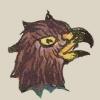Cozcacuauhtenanco (Mdz13r)
This compound glyph for the place name Cozcacuauhtenanco features a cozcacuauhtli, which is a king vulture and a calendrical symbol, and a turquoise blue parapet or rampart (tenantli). The vulture is shown as just a head, in profile, looking toward the viewer's left. Its visible eye and beak are both open. The beak is a tan color, and the head of the vulture is a purple-gray. A red protrusion appears above the beak, and a red ring appears at the neck--like a necklace (cozcatl), which is a phonetic indicator for that part of the word for king vulture (cozcacuauhtli). It also wears a white earring. The rampart has a horizontal rectangle with four circles inside it, and each circles contains a smaller concentric one. Along the top of this rectangular wall are three stepped elements like crenellation.
Stephanie Wood
Gordon Whittaker (Deciphering Azted Hieroglyphs, 2021, 78) describes the king vulture's iconography as a visual compound of necklace and king vulture, rather than a compound of necklace and eagle, which is what the word cozcacuauhtli sounds like. Thus, he calls the necklace a "semantic indicator that reinforces the value of the avian logogram." The necklace is just a hint of a real necklace, primarily comprised of a natural ruffle, perhaps, although the cozcacuauhtli glyph of the Codex Magliabecchiano wears a necklace of shells. For further comparison, see the cozcacuauhtli glyph in Tlachia (UNAM, 2018).
Frances Karttunen's interpretation of the wall as being indicative of a "fort," suggests she sees it more than a wall, but rather a rampart or parapet, as both are defensive features of architecture.
Stephanie Wood
cozcaquauhtenanco, puo
Cozcacuauhtenanco, pueblo
Stephanie Wood
c. 1541, or by 1553 at the latest
Stephanie Wood
parapets, ramparts, merlons, walls, crenellation, almena, almenas, king vultures, eagles, birds, necklaces, fortalezas, murallas, parapetos, almenas, nombres de lugares, ave, aves, pájaro, pájaros, pluma, plumas, animals, animales
This example of a carved stone hieroglyph representing the date Matlactli Cozcacuauhtli (Ten Vulture, or 10-Vulture) shows the head of the vulture in profile, facing left. It has a hooked beak, characteristic of the bird. It may also have an earring, something like the earring worn by the bird in the glyph for Cozcacuauhtenanco, above. The stone carving is located on the Templo Calendárico at the Tlatelolco archaeological site. Photo by R. Haskett, 2 May 2025.

cozcacuauh(tli), king vulture, redheaded eagle, https://nahuatl.wired-humanities.org/content/cozcacuauhtli-0
cozca(tl), necklace, https://nahuatl.wired-humanities.org/content/cozcatl-0
cuauh(tli), eagle, https://nahuatl.wired-humanities.org/content/cuauhtli
tenan(tli), wall, fortification, https://nahuatl.wired-humanities.org/content/tenantli
tenami(tl), wall, fortification, https://nahuatl.wired-humanities.org/content/tenamitl
-co (locative suffix), https://nahuatl.wired-humanities.org/content/co
"At Fort Vulture" [Frances Karttunen, unpublished manuscript, used here with her permission.]
"At the Walls of the King Vulture" (Whittaker, 2021, 78); "On the Wall of the Vulture" (Berdan and Anawalt, 1992, vol. 1, p. 181)
COZCACOZCACUAUH-TENAN.
"En la Muralla del Buitre" o "En la Fortaleza del Buitre"
Gordon Whittaker; Stephanie Wood
Codex Mendoza, folio 13 recto, https://digital.bodleian.ox.ac.uk/objects/2fea788e-2aa2-4f08-b6d9-648c00..., image 36 of 188.
The Bodleian Libraries, University of Oxford, hold the original manuscript, the MS. Arch. Selden. A. 1. This image is published here under the UK Creative Commons, “Attribution-NonCommercial-ShareAlike 3.0 License” (CC-BY-NC-SA 3.0).




